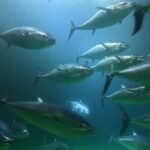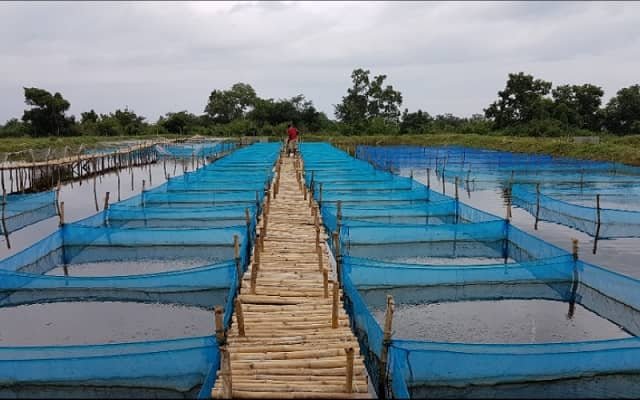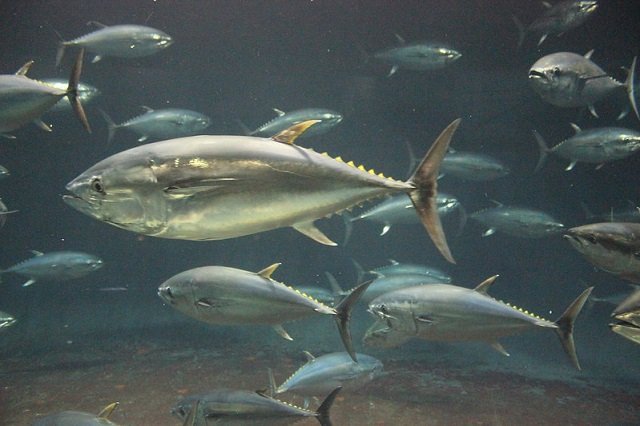
Tuna is one of the most coveted fish in the world. Its flesh, prized in high cuisine and a cornerstone of sushi and sashimi, has driven a seemingly insatiable global demand. However, this voracious appetite comes at a very high cost: overfishing has pushed several wild tuna populations to the brink of collapse, creating a critical dilemma for marine ecosystems and food security.
For decades, fishing fleets from all over the world have pursued tuna across the oceans. There are 23 stocks of the main tuna species (MSC, 2025), and organizations like the International Commission for the Conservation of Atlantic Tunas (ICCAT) have implemented strict quotas to prevent the commercial extinction of these species, but illegal and unreported fishing remains a significant threat.
What is tuna farming? A complex solution to a global problem
- 1 What is tuna farming? A complex solution to a global problem
- 2 Global production of tuna through aquaculture
- 3 Key concepts: Understanding the terminology of tuna farming
- 4 Tuna reproduction
- 5 Diseases affecting farmed tuna
- 6 The crucial challenge: Feeding
- 7 Is tuna farming truly sustainable?
- 8 Comparison of ranching vs. closed-cycle vs. fishery
- 9 Conclusion
- 10 Frequently Asked Questions (FAQ) about Tuna Farming
- 11 References
- 12 Entradas relacionadas:
This is where tuna farming comes into play. Technically known as tuna aquaculture, this emerging field presents a potential alternative to extractive fishing. In essence, it involves raising tuna in controlled environments, either at sea or, more recently, on land. The objective is twofold: to meet market demand and, in theory, to alleviate pressure on wild populations. As we will see, this solution is not simple and presents its own challenges and controversies.
Information on tuna farming is often fragmented and can be confusing. Is “fattening” tuna the same as “farming” them? What are the species of farmed tuna? This article seeks to answer these questions. We will analyze the different methods in depth, break down their advantages and disadvantages, and explore the latest innovations that are defining the future of how tuna will reach our tables.
Global production of tuna through aquaculture
Of the 23 species of tuna, only 3 are utilized in aquaculture. In the period from 2014 to 2023, the global production of tuna through aquaculture increased from 42,911.11 metric tons of live weight in 2014 to 67,748 in 2023, which represents an average annual growth rate of 5.74%.
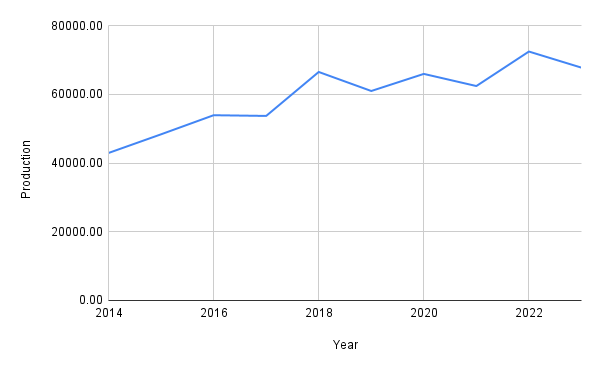
Top producing countries
The main countries producing tuna through aquaculture can be classified into three groups:
- Leaders: Malta, Japan, and Spain are the countries that have surpassed an annual production of 10,000 metric tons of live weight. However, Japan’s leadership was challenged by Malta, which surpassed its production in 2023. Meanwhile, Spain broke the 10,000 metric ton barrier of live weight in 2022. All three countries showed a growing trend in tuna production in the period from 2014 to 2023; while Japan grew at an average annual rate of 1.91%, Malta and Spain grew at average annual rates of 17.98% and 17.55%, respectively.
- Stable: Australia and Mexico are the tuna-producing countries that have remained between 5,000 and 10,000 metric tons of live weight. While Australia registered an average annual growth rate of 0.90%, Mexican production showed a more erratic trend.
- Emerging: Croatia and Turkey can be classified as emerging countries in tuna production during the period studied. Croatia registered an average annual growth rate of 8.44%, while Turkey grew at an average annual rate of 22.9%. With much lower production, Tunisia, and in the last three years, Albania and Portugal, are also emerging as tuna producers.
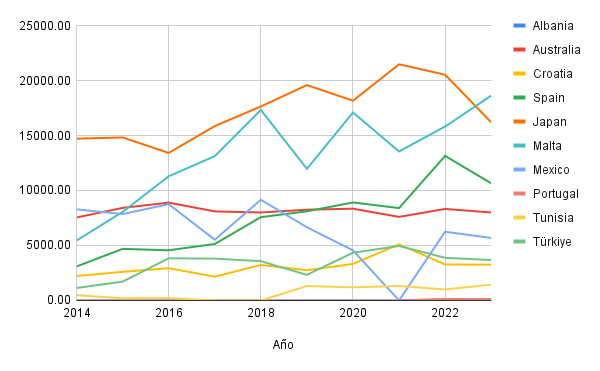
Main production zones
The main tuna production zones include the Mediterranean and Black Sea (Albania, Croatia, Spain, Malta, Tunisia, and Turkey), followed by the Northwest Pacific (Japan). However, while production in the Mediterranean and Black Sea shows a growing trend, production in the Northwest Pacific has remained stable overall, with a decrease in production in recent years.
On the other hand, while production in the Indian Ocean (Australia) has remained stable during the period from 2014 to 2023, production in the Eastern Central Pacific (Mexico) shows a decreasing trend. Finally, the Northeast Atlantic (Portugal) shows an incipient production.
Stay Always Informed
Join our communities to instantly receive the most important news, reports, and analysis from the aquaculture industry.

Production by species
The main farmed tuna species include, in order of importance, Thunnus thynnus “Atlantic bluefin tuna”, Thunnus orientalis “Pacific bluefin tuna”, and Thunnus maccoyii “Southern bluefin tuna”. However, while the “Atlantic bluefin tuna” shows a growing trend in production, the T. orientalis and T. maccoyii species have recorded stable production. It is important to note that, to date, the reproductive and production life cycle has been closed for the T. orientalis and T. thynnus species.

Key concepts: Understanding the terminology of tuna farming
To navigate this topic, it is essential to understand the specific terminology used in the industry.
“Ranching” vs. “Closed-Cycle”
This is the most important distinction and the source of most of the confusion. Not all tuna “farming” is the same.
- Tuna ranching (or Penning): This method, also known as capture-based aquaculture, is the oldest and most widespread, especially in the Mediterranean (Croatia, Spain) and Australia. It consists of capturing young or adult tuna at sea and transferring them to large marine pens or cages. There, they are intensively fed to increase their weight and fat percentage before being harvested.
- Closed-Cycle aquaculture: This is true tuna “aquaculture.” It involves controlling the entire life cycle of the fish in captivity: from the reproduction of the parents (broodstock), the hatching of eggs, the rearing of larvae and juveniles, to the final grow-out for the market. This method does not extract fish from wild populations (except perhaps for the initial broodstock).
The traditional method: Tuna ranching (or penning)
Tuna ranching has been the pillar of the industry for years, allowing for a constant supply to markets like Japan.
The step-by-step process
- Capture of wild juveniles: Purse seiners locate and surround schools of tuna. The nets are closed, capturing the fish with the least possible harm.
- Transfer to sea pens: The tuna are carefully transferred to towing cages and slowly brought to the fattening areas, usually protected bays. Once there, they are moved to fixed anchor pens.
- Intensive feeding and growth: For several months, the tuna are fed large quantities of bait fish (sardines, mackerel, squid) to rapidly increase their weight and fat percentage, which determines their commercial value.
Advantages of tuna ranching
- Lower initial technical complexity: Compared to the closed-cycle method, ranching does not require the highly sophisticated technology for reproduction and larval rearing, which are extremely fragile stages.
- Contribution to global supply: It has allowed countries like Croatia to become major players in the tuna market.
Disadvantages and criticisms of ranching
- Continued dependence on wild populations: The fundamental criticism is that it does not solve the problem of overfishing but rather transforms it. It continues to extract biomass from the ocean to start the process. Jelić et al. (2023) reported that the main limitation for the sustainability of Atlantic bluefin tuna farming in the Mediterranean is its complete dependence on the capture of wild tuna for stocking the farms and on wild small pelagic fish for feed.
- The debate on real sustainability: Although presented as a form of “farming,” many ecologists argue that ranching is simply the final phase of a fishery, with a considerable ecological footprint due to the need to capture large volumes of bait fish to feed the tuna.
- Animal welfare: Chandararathna et al. (2021) state that, unlike domesticated fish, fish used in capture-based aquaculture are not genetically adapted to the intensive conditions of fish farms, and their stress response may be different.
The closed-cycle revolution: The future of tuna farming
Closed-cycle farming is the holy grail of the industry. It is the only way to produce tuna without relying on wild catches and represents the hope for truly sustainable long-term production.
This method encompasses the entire life cycle of the tuna in a controlled environment. Broodstock tuna, kept in captivity, spawn. The fertilized eggs are collected and incubated, and the resulting larvae are raised on special diets until they become juveniles, which then grow to market size.
Pioneers in technology: The case of Kinki University in Japan
The most notable effort in this field was made by Kinki University (now Kindai University) in Japan; after more than 30 years of research, in 2002, they managed for the first time to close the life cycle of the Pacific bluefin tuna in captivity. This milestone proved that it was possible and opened the door to the commercialization of “Kindai” tuna, raised entirely on farms.
Types of closed-cycle systems
Closed-cycle technology for tuna aquaculture is being developed on two main fronts:
Open-sea systems: Floating cages
They are similar to ranching pens but house tuna born in hatcheries. The technology here focuses on more robust cages to withstand open-sea conditions and on automated feeding and remote monitoring systems to optimize growth and minimize escapes.
Land-Based Aquaculture
This is the most recent and promising innovation in tuna aquaculture. It involves raising tuna in large tanks in land-based facilities. This offers almost complete control over water conditions (temperature, salinity, oxygen), eliminates the risk of escapes, and minimizes the direct environmental impact on the ocean. An article in The Guardian from September 2023 highlighted a breakthrough: Spanish researchers achieved the reproduction of Atlantic bluefin tuna in land-based tanks for the first time. This has spurred companies like Next Tuna to plan the construction of the first large-scale commercial land-based tuna farms.
Water quality for tuna aquaculture
For rearing yellowfin tuna (Thunnus albacares) juveniles, Sun et al. (2024) recommend keeping the ammonia nitrogen concentration below 5 mg/L and the duration of stress within 36 hours to improve antioxidant capacity; they also indicate that if the concentration is between 5 and 10 mg/L, the stress duration should not exceed 24 hours. On the other hand, Meyer and Emam (2024) report that the suggested water temperature for Atlantic bluefin tuna (Thunnus thynnus) aquaculture is 18 to 30°C, and they spawn in warmer waters (over 24°C).
Key advantages of closed-cycle
- Independence from wild populations: This is the most significant advantage. It allows for the production of tuna without affecting the already depleted ocean stocks.
- Total control over the process and quality: From genetics to feeding, the entire process can be monitored and optimized, resulting in a consistent, high-quality product. It allows for complete traceability from egg to plate.
- Reduction of direct environmental impact: Especially in land-based systems with water recirculation, waste can be treated, water use reduced, and pollution of the marine ecosystem eliminated.
Challenges of closed-cycle farming
- High technical complexity and investment costs: Replicating the oceanic conditions a tuna needs to thrive is a monumental challenge. It requires large investments in infrastructure and technology.
- The feeding challenge: This is a problem shared with ranching, but is crucial for the sustainability of the closed-cycle method. We will address this in the next section.
- Availability of juveniles: The profitable production of BFT juveniles is not yet commercially viable due to challenges such as egg shortages, low survival of larvae and juveniles, and mortality during transfer (Guillen et al., 2024).
- Animal welfare in controlled environments: Tuna are high-speed pelagic swimmers. Ensuring their welfare in tanks or cages is an ethical and technical challenge that requires special tank designs and low stocking densities. Meyer and Emam (2024) highlight that stress is a primary concern for animal welfare in the closed-cycle farming of Atlantic bluefin tuna (T. thynnus).
Tuna reproduction
The consolidation of tuna aquaculture as a sustainable and predictable industry fundamentally depends on the ability to control and optimize its entire life cycle in captivity. Overcoming the complex biological challenges associated with reproduction and the early life stages is the cornerstone for reducing dependence on wild populations. Recent advances in biotechnology and animal husbandry are marking a turning point, transforming the viability of industrial-scale production. Below, we cite some of the experiences that have been carried out with the main tuna species:
Spawning induction
The research of Higuchi et al. (2024) and Nyuji et al. (2025) demonstrates that by controlling photoperiod regimes, it is possible not only to induce spontaneous spawning but also to advance sexual maturation by several months, allowing for more efficient planning of the production cycle.
Higuchi et al. (2024) reported that a change from a short photoperiod (10.5 hours light: 13.5 hours dark) to a long one (15 hours light: 9 hours dark) in December induced spontaneous spawning of the Pacific bluefin tuna (Thunnus orientalis) in March, approximately three months before its normal spawning season (late April to October, with a peak between June and July).
Meanwhile, Nyuji et al. (2025) concluded that the manipulation of a phase-shifted photoperiod regime is a powerful technique for advancing maturation and spawning in 3-year-old Pacific bluefin tuna (Thunnus orientalis); and highlights that the method, which involves transferring fish from sea cages to indoor land-based tanks and exposing them to an advanced photoperiod cycle, manages to initiate spawning 2 or 3 months before the normal season.
Spawning
Bramantya et al. (2021) reported the natural spawning technique of yellowfin tuna (Thunnus albacares) in floating net cages; they indicated that the ratio of males to females for spawning is 3 males to 1 female, and they state that broodstock ready to spawn measure 20 kg and are one year old.
Surrogate reproduction
Normally, Pacific bluefin tuna take 3 to 5 years to reach sexual maturity and weigh nearly one hundred kilograms to spawn in captivity; in this regard, Kawamura et al. (2024) successfully demonstrated that xenogeneic germ cells (from a different species) of Pacific bluefin tuna (Thunnus orientalis) can be transplanted into the peritoneal cavity of small hybrid tuna larvae (HLT, from the genus Euthynnus), which allowed them to obtain functional Pacific bluefin tuna sperm at only 8 months of age and with a body size of 1 kg.
Egg quality evaluation
Ienaga et al. (2021) successfully established a system that uses deep neural networks (specifically, a CNN model) to predict the quality of Pacific bluefin tuna (Thunnus orientalis) eggs based solely on photographic images. The proposed system predicted the eggs that would hatch normally with an accuracy superior to that of human experts.
Egg transport
The results of the research by Hayashida et al. (2023b) on the transport of Pacific bluefin tuna eggs indicate that the eggs should be transported at a density of 1 × 10^4 eggs/L within 12 hours under field conditions; it also demonstrated that treatment with polyethylene glycol – PEG (at 1000 μg/mL for 12 hours) could reduce damage from physical shock.
Hatching
Ruiz-Jarabo et al. (2022) found that the highest hatching rates of Atlantic bluefin tuna (Thunnus thynnus) eggs occurred in the salinity range of 33 to 49 ppt, averaging 84.0 ± 3.5%, decreasing drastically to 55.9 ± 9.3% at the lowest tested salinity (27 ppt).
Larval rearing
Bramantya et al. (2021) reported that the rearing of yellowfin tuna (Thunnus albacares) larvae is carried out in 6,000 L and 10,000 L fiber tanks and that the feeding of the larvae begins before their critical period, specifically on the second day (D2) after hatching, when the larvae begin to open their mouths. The optimal water quality parameters for rearing yellowfin tuna larvae are: temperature 29-30°C, pH 8.2, and dissolved oxygen (DO) 6.0 ppm. The salinity ranges from 34-35 ppt and the water is clear.
Ruiz-Jarabo et al. (2022) report that Atlantic bluefin tuna (Thunnus thynnus) larvae achieve the highest survival rates in the range of 33 to 40 ppt, averaging 79.7 ± 3.8% survival.
Sex reversal
Farmed male Pacific bluefin tuna (Thunnus orientalis) are larger than females; Hayashida et al. (2023a) induced the masculinization of Pacific bluefin tuna juveniles through the oral administration of letrozole.
Diseases affecting farmed tuna
Microsporidian
López-Verdejo et al. (2022) described a new species of microsporidian, a type of parasitic fungus, called Glugea thunni, which affects farmed Atlantic bluefin tuna (Thunnus thynnus) in the Spanish Mediterranean. Glugea thunni was associated with a highly severe pathology of the visceral cavity in juvenile bluefin tuna, compromising the fish´s survival.
The crucial challenge: Feeding
The biggest obstacle to truly sustainable tuna farming is the food. Tuna are carnivores and require a diet rich in protein and fat.
The problem of the Feed Conversion Ratio (FCR)
The Feed Conversion Ratio (FCR) measures how many kilograms of feed are needed to produce one kilogram of fish. Historically, for tuna, this ratio has been very inefficient, sometimes requiring more than 9 kg (Guillen et al., 2024) or 10 to 20 kg (Jelić et al., 2023) of bait fish to produce 1 kg of tuna. This means that, instead of creating protein, tuna aquaculture was, in effect, consuming it at a net negative rate.
Development of an artificial diet
Murashita et al. (2021) found differences in the enzymatic activity of Pacific bluefin tuna (Thunnus orientalis) juveniles fed with raw fish versus a commercial feed. They determined that the biochemical characteristics of digestive enzymes and the observed effects of the artificial diet on digestive physiology could be good indicators for improving feeding strategies, such as diet composition, feed ration, and feeding frequency in juvenile tuna.
The search for alternatives to fishmeal and fish Oil
The solution lies in developing formulated feeds that do not depend on wild fish. The industry is advancing rapidly in this area.
- Extruded Feeds (Buhler Case): Technology companies like the Buhler Group have pioneered the development of extruded feeds for tuna. As they describe on their website, they have managed to create pellets that are not only nutritionally complete but also have the right texture and palatability for tuna to accept them. These feeds aim to drastically reduce the proportion of fishmeal and fish oil, replacing them with plant-based proteins and other sustainable sources.
- Insect Proteins and Other Innovations: Research is expanding into new frontiers, such as the use of insect meal, algae, and other non-marine proteins to formulate the next generation of tuna feeds.
Is tuna farming truly sustainable?
The answer is not a simple yes or no. It depends entirely on the method and specific practices.
Arguments in favor: Relieving fishing pressure
Proponents, especially of land-based closed-cycle farming, argue that it is the only realistic way to meet future demand without emptying the oceans. By creating a contained and controlled production system, we can allow wild populations to recover.
Arguments against: Ecological impact and ethics
Critics point out that even with improved feeds, the massive scale of production required will still have an ecological footprint. Furthermore, ethical questions arise about the welfare of such a magnificent and wild animal in an intensive farming environment. Jelić et al. (2023) and Guillen et al. (2024) state that the sustainability of tuna aquaculture is limited due to the dependence on the capture of wild tuna for fattening and on wild small pelagics for feed.
The role of regulation and certifications (ICCAT, MSC, etc.)
For consumers to make informed decisions, third-party certifications are crucial. Seals like the one from the Marine Stewardship Council (MSC) are developing standards for tuna farming that address both environmental sustainability and social responsibility.
Comparison of ranching vs. closed-cycle vs. fishery
One of the main concerns for consumers is choosing tuna that comes from sustainable sources. The consumer faces questions like: what is the best option? With terms like “wild” or “farmed,” the decision can be confusing. But did you know that not all “farmed” tuna is the same and that the impact of each method on our oceans is very different? To help you truly understand what is behind each product and make a more informed decision, we have created the following comparison table. Here we break down in a simple way the three main ways tuna reaches your table: traditional open-sea fishing, “fattening” or ranching (an intermediate practice), and the innovative closed-cycle farming. We analyze the key differences in aspects that matter to you: from sustainability and environmental impact to the quality control of the fish you take home. You can review this article where we offer a detailed comparison of aquaculture fish and wild fish.
Comparison table: Fattening and Closed-Cycle Fishing and Wild Fishing.
| Feature | Tuna Ranching | Closed-Cycle Aquaculture | Wild-Caught |
|---|---|---|---|
| Source of Fish | Capture of wild juveniles/adults | Hatchery-raised from managed broodstock | Capture of wild adults |
| Sustainability | Low (dependent on wild stocks) | Potentially high (independent of wild stocks) | Generally low (risk of overfishing) |
| Environmental Impact | High (local pollution, pressure on bait fish stocks) | Moderate to low (especially land-based) | High (bycatch, habitat damage) |
| Investment Cost | Moderate to High | Very High | High (vessels, fuel) |
| Quality Control | Moderate | Very High | Variable |
| Feed Source | Mainly bait fish | Mainly formulated feeds | Natural ocean diet |
Conclusion
Tuna aquaculture is an industry at a crossroads, full of potential but also fraught with dangers. The main conclusions are:
- Ranching, although dominant, is not a long-term sustainable solution due to its dependence on wild fish and its environmental impact.
- Closed-cycle farming, especially in land-based systems, represents the most promising path toward truly sustainable tuna production by eliminating pressure on wild populations.
- The greatest challenge for the entire industry is the development of sustainable feeds that break the dependence on fishmeal.
The ideal future combines a reduction in global consumption, much stricter and more effective fisheries management for wild populations, and the development of responsible and transparent closed-cycle aquaculture. Technology is advancing at a dizzying pace, and what seemed impossible a decade ago, like raising tuna on land, is now on the commercial horizon.
Final recommendation for the conscious consumer
As a consumer, your power lies in your choice. Inform yourself about the origin of the tuna you buy. Look for products with credible sustainability certifications. Question and ask. Supporting producers who invest in closed-cycle technologies and sustainable feeds can help steer the entire industry toward a better future—one where we can enjoy tuna without compromising the health of our oceans.
Frequently Asked Questions (FAQ) about Tuna Farming
Can tuna be farmed in captivity?
Yes. Thanks to decades of research, primarily in Japan and now also in Europe, it is possible to raise tuna (both Pacific and Atlantic) through a complete life cycle in captivity (closed-cycle). However, the technology is complex and expensive, so it is not yet widespread on a massive scale.
Is farmed tuna healthy?
Generally, yes. Farmed tuna has a controlled fat content, which is often higher than that of its wild counterparts, resulting in high levels of Omega-3 fatty acids. Being in a controlled environment, it may also have lower levels of contaminants like mercury, although this depends on the quality of the feed and water.
What environmental problems does tuna farming cause?
The main problem with the traditional ranching method is water pollution from excess nutrients (feces and uneaten feed), which damages the seabed. Additionally, both methods have historically depended on large quantities of wild fish for feed, which puts pressure on other species. Land-based closed-cycle systems aim to solve these problems by treating the water and using more sustainable feeds.
How can I know if the tuna I buy is sustainable?
Look for third-party certifications on the packaging. For wild-caught tuna, the Marine Stewardship Council (MSC) is the gold standard. If there is no certification, try to research the brand or supplier to understand their methods.
Is farmed tuna more expensive than wild-caught?
It depends on the type and quality. High-quality, closed-cycle farmed bluefin tuna can be very expensive due to high production costs. However, as the technology becomes more efficient and scales up, prices are expected to become more competitive. In some cases, ranched tuna can have a similar or slightly lower price than comparable quality wild-caught tuna.
References
Bramantya, B., Gunawan, & Sari, L. A. (2021). Spawning technique of yellowfin tuna (Thunnus albacares) in floating nets cage. IOP Conference Series: Earth and Environmental Science, 679(1), 012029. https://doi.org/10.1088/1755-1315/679/1/012029
Chandararathna, U., Iversen, M. H., Korsnes, K., Sørensen, M., & Vatsos, I. N. (2021). Animal Welfare Issues in Capture-Based Aquaculture. Animals, 11(4), 956. https://doi.org/10.3390/ani11040956
Guillen, J., Asche, F., Carvalho, N., Druon, J., Llorente, I., Sciberras, A., Višnić Novaković, S., & Vukov, I. (2024). How sustainable is tuna aquaculture? A methodology to assess the sustainability of seafood production systems. Frontiers in Aquaculture, 3, 1422372. https://doi.org/10.3389/faquc.2024.1422372
Hayashida, T., Higuchi, K., Okita, K., Kazeto, Y., Hamasaki, M., Yoshikawa, S., Takashi, T., & Gen, K. (2023a). First Data on Sexual Dimorphic Growth of Cultured Pacific Bluefin Tuna, Thunnus orientalis (Temminck et Schlegel), and Its Sex Manipulation by Treatment with an Aromatase Inhibitor. Aquaculture Research, 2023(1), 1590646. https://doi.org/10.1155/2023/1590646
Hayashida, T., Higuchi, K., Hashimoto, H., Kazeto, Y., & Takashi, T. (2023b). Optimization of stocking density and shipping duration for transportation of Pacific bluefin tuna, Thunnus orientalis (Temminck et Schlegel), eggs, and experimental verification of polyethylene glycol treatment to reduce collision damage. Journal of the World Aquaculture Society, 54(6), 1513-1521. https://doi.org/10.1111/jwas.12972
Higuchi, K., Takashi, T., Okita, K., Hayashida, T., Nyuji, M., & Gen, K. (2024). Effect of a long photoperiod on the timing of spawning in the Pacific bluefin tuna, Thunnus orientalis. Aquaculture Reports, 36, 102062. https://doi.org/10.1016/j.aqrep.2024.102062
Ienaga, N., Higuchi, K., Takashi, T., Gen, K., Tsuda, K., & Terayama, K. (2021). Vision-based egg quality prediction in Pacific bluefin tuna (Thunnus orientalis) by deep neural network. Scientific Reports, 11(1), 1-10. https://doi.org/10.1038/s41598-020-80001-0
Jelić Mrčelić, G., Nerlović, V., Slišković, M., & Zubak Čižmek, I. (2023). An Overview of Atlantic Bluefin Tuna Farming Sustainability in the Mediterranean with Special Regards to the Republic of Croatia. Sustainability, 15(4), 2976. https://doi.org/10.3390/su15042976
Kawamura, W., Yazawa, R., Takeuchi, Y. et al. Bluefin tuna sperm production is hastened by surrogacy in small Euthynnus. Nat Commun 15, 8128 (2024). https://doi.org/10.1038/s41467-024-52393-4
López-Verdejo, A., Montero, F.E., de la Gándara, F. et al. A severe microsporidian disease in cultured Atlantic Bluefin Tuna (Thunnus thynnus). IMA Fungus 13, 5 (2022). https://doi.org/10.1186/s43008-022-00090-6
Marine Stewardship Council. MSC. (2025). Sustainable Tuna Yearbook 2025. Recuperado de https://www.msc.org/tuna
Meyer, B., & Emam, W. (2024). Welfare implications of closed-cycle farming of Atlantic bluefin tuna (Thunnus thynnus). Frontiers in Animal Science, 5, 1445306. https://doi.org/10.3389/fanim.2024.1445306
Murashita, K., Hashimoto, H., Takashi, T., Eba, T., Kumon, K., Matsunari, H., Soma, S., Oku, H., Furuita, H., Yoshinaga, H., & Yamamoto, T. (2021). Characterization of digestive physiology in Pacific bluefin tuna Thunnus orientalis juveniles fed a raw fish feed and a commercial diet. Aquaculture, 538, 736562. https://doi.org/10.1016/j.aquaculture.2021.736562
Nyuji, M., Soma, S., Higuchi, K., Takashi, T., Okita, K., Hayashida, T., Ishii, K., Yokota, T., Kuruma, Y., Gen, K., & Mori, K. (2025). Spawning performance of 3-year-old Pacific bluefin tuna Thunnus orientalis exposed to a phase-shifted photoperiod regime. Aquaculture, 594, 741359. https://doi.org/10.1016/j.aquaculture.2024.741359
Ruiz-Jarabo, I., Laiz-Carrión, R., Ortega, A., De la Gándara, F., Quintanilla, J., & Mancera, J. (2022). Survival of Atlantic bluefin tuna (Thunnus thynnus) larvae hatched at different salinity and pH conditions. Aquaculture, 560, 738457. https://doi.org/10.1016/j.aquaculture.2022.738457
Sun, Y., Fu, Z., & Ma, Z. (2024). The effects of acute ammonia stress on liver antioxidant, immune and metabolic responses of juvenile yellowfin tuna (Thunnus albacares). Comparative Biochemistry and Physiology Part A: Molecular & Integrative Physiology, 297, 111707. https://doi.org/10.1016/j.cbpa.2024.111707
Xie, J., Bian, Z., Wu, Q., Tao, L., Wu, F., & Lin, T. (2023). Global knowledge domain and prospects in tuna research: A bibliometric analysis. Aquaculture and Fisheries, 8(2), 202-210. https://doi.org/10.1016/j.aaf.2021.09.005
Editor at the digital magazine AquaHoy. He holds a degree in Aquaculture Biology from the National University of Santa (UNS) and a Master’s degree in Science and Innovation Management from the Polytechnic University of Valencia, with postgraduate diplomas in Business Innovation and Innovation Management. He possesses extensive experience in the aquaculture and fisheries sector, having led the Fisheries Innovation Unit of the National Program for Innovation in Fisheries and Aquaculture (PNIPA). He has served as a senior consultant in technology watch, an innovation project formulator and advisor, and a lecturer at UNS. He is a member of the Peruvian College of Biologists and was recognized by the World Aquaculture Society (WAS) in 2016 for his contribution to aquaculture.
